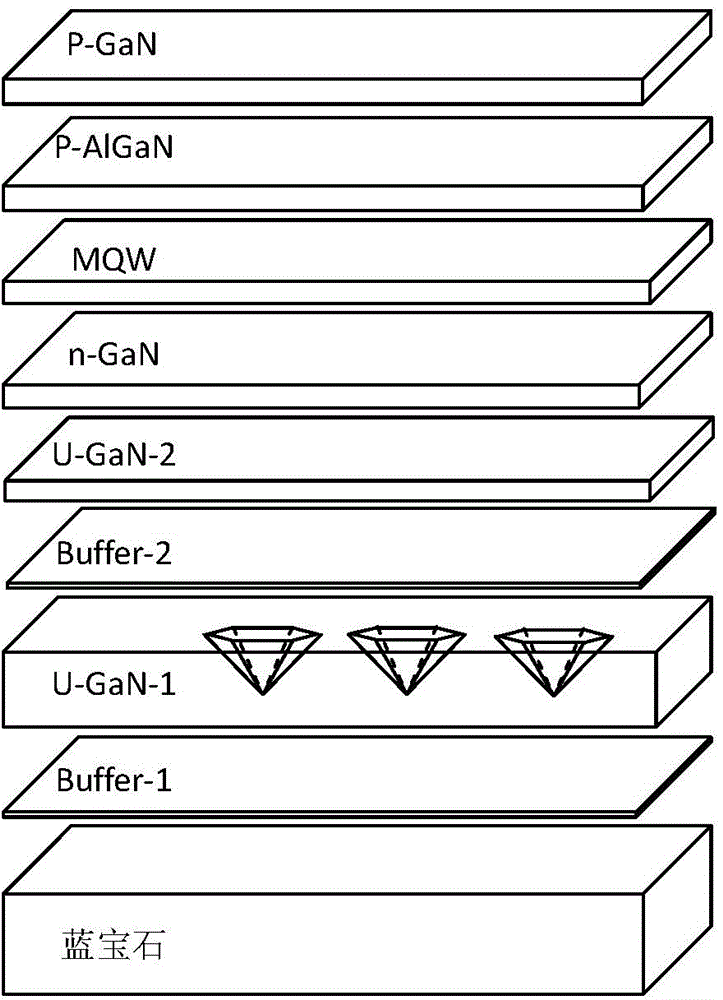Transverse epitaxial growth method for double buffer layers for improving brightness of LED (Light Emitting Diode)
A technology of lateral epitaxial growth and double buffer layers, applied in the direction of electrical components, circuits, semiconductor devices, etc., can solve the problems of complex process, time-consuming samples, secondary pollution, etc., achieve simple process, reduce absorption, increase overall reflection effect
- Summary
- Abstract
- Description
- Claims
- Application Information
AI Technical Summary
Problems solved by technology
Method used
Image
Examples
Embodiment 1
[0025] 1. Put the cleaned sapphire substrate into the MOCVD equipment and bake it at 1100°C for 10 minutes.
[0026] 2. A low-temperature buffer-1 layer with a thickness of 20nm is grown at a temperature of 520°C, and the growth pressure is 500torr.
[0027] 3. Raise the temperature to 1050°C to grow a layer of undoped U-GaN-1 layer with a thickness of about 2.0um, and the growth pressure is 100torr.
[0028] 4. In the NH3 environment, raise the temperature to 1170°C, anneal for 5 minutes, and the pressure is 200torr.
[0029] 5. Lower the temperature to 650°C to grow a low-temperature buffer-2 layer with a thickness of 20nm and a growth pressure of 500torr.
[0030] 6. Then raise the temperature to 1160°C to grow a layer of undoped U-GaN-2 layer with a thickness of about 1.0um, and the growth pressure is 100torr.
[0031] 7. Raise the temperature to 1170°C, grow a layer of n-GaN doped with silane with a thickness of 2.0um, and grow at a growth pressure of 100torr.
[0032]...
Embodiment 2
[0038] 1. Put the cleaned sapphire substrate into the MOCVD equipment and bake it at 1100°C for 10 minutes.
[0039] 2. Lower the temperature to 650°C to grow a low-temperature buffer-2 layer with a thickness of 20nm and a growth pressure of 500torr.
[0040] 3. Then raise the temperature to 1160°C to grow a layer of undoped U-GaN-2 layer with a thickness of about 1.0um, and the growth pressure is 100torr.
[0041] 4. Raise the temperature to 1170° C., grow a layer of n-GaN doped with silane with a thickness of 2.0 um, and grow at a growth pressure of 100 torr.
[0042] 5. Switch the carrier gas from hydrogen to nitrogen at a pressure of 100 torr to grow multiple quantum well layers.
[0043] 6. Switch the carrier gas from nitrogen to hydrogen, and grow a p-type AlGaN layer with a thickness of 20nm and a growth pressure of 100torr at a temperature of 1185°C and 150torr.
[0044]7. The temperature is 1080°C, a layer of p-type GaN doped with Mg is grown with a thickness of 150...
PUM
 Login to View More
Login to View More Abstract
Description
Claims
Application Information
 Login to View More
Login to View More - R&D
- Intellectual Property
- Life Sciences
- Materials
- Tech Scout
- Unparalleled Data Quality
- Higher Quality Content
- 60% Fewer Hallucinations
Browse by: Latest US Patents, China's latest patents, Technical Efficacy Thesaurus, Application Domain, Technology Topic, Popular Technical Reports.
© 2025 PatSnap. All rights reserved.Legal|Privacy policy|Modern Slavery Act Transparency Statement|Sitemap|About US| Contact US: help@patsnap.com



